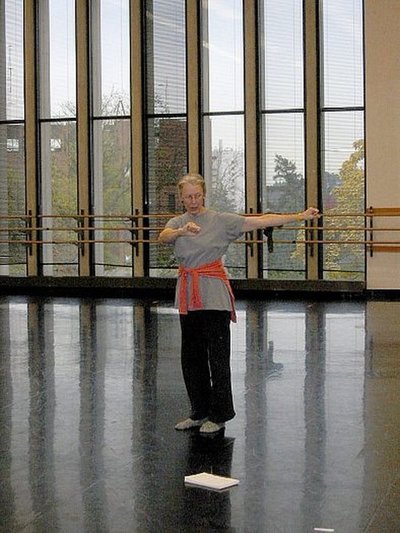January 19, 2006
Ex-Limón dancer re-creates There is a time
Thanks to the Byrds, you don’t have to be a Biblical scholar to be familiar with the verses from Ecclesiastes, the ones about there being “a time for every purpose under Heaven.” The UW’s Chamber Dance Company will be performing a dance inspired by those very same verses in its concert next weekend, but the Byrds’ recording won’t be the accompaniment.
The dance, There is a Time, was originally choreographed by José Limón in 1956, before the Byrds began their career, and features a Pulitzer Prize-winning score by Norman Dello Joio. It’s that music that will be heard as the CDC re-creates the work, which it was able to do with assistance from former Limon dancer Sarah Stackhouse.
Stackhouse came to the UW in October and spent several weeks working with the dancers. She performed, she says, just about every female role in the dance during her active career with the Limon company, which lasted 11 years.
Stackhouse is one of a long line of guest artists who have come to the UW to help the CDC re-create important historical dances. Thanks to these visitors, the company has been able to reconstruct classics from such major modern dance figures as Isadora Duncan, Martha Graham, Paul Taylor and many others.
Stackhouse was in high school when she first met Limón. Having earned a scholarship to the American Dance Festival, she took classes from him there and was “viscerally drawn” to his work. She went on to college, but as soon as she graduated she was off to New York to take classes from him. She joined his company from there.
“There is a Time is one of José’s larger works, but it’s made up of small pieces,” Stackhouse explained. “Each part illustrates a portion of the verses. There’s a time be born, a time to die, a time to plant, and so forth.”
The parts are performed by small groups of dancers — solos, duets, trios. Only in the opening and closing are all 14 dancers included (the six-member CDC is being augmented by undergraduate and Seattle community dancers).
“Limón did almost all his formal work in very small groups,” Stackhouse said. “The smaller the group, the more you have to take space in as part of the character. You push, gather, are moved by space. A single dancer can be powerful. When there are only four people on stage, the detail on everything they do has to be very well differentiated. You have to see the space filling, the dancer having fullness of detail and expression.”
Two other qualities of Limón’s style that Stackhouse noted are the sense of gravity — the “feeling of resting on the Earth, being supported by the Earth” — and the breath quality.
“Much of José’s work is in a romantic vein, so there always a sense of pulling the breath and letting it go. It’s like what’s called rubato in music; you steal from one measure of time, let it last, suspend, and then catch it up in the next measure.”
Stackhouse said she always returns to films of Limón performances when she begins a reconstruction. “To try to do what those early dancers do, to get the expression in the same way would be foolish,” she said. “It would be an imitation and it would look bad. So what I do when I look at the films is to just understand what (Limón) was getting at in the dance. To understand the bones of the movement, rather than all of the flesh, which often was really furnished by those dancers.”
She’s been very pleased with the dancers she’s worked with at the UW. “These dancers are very very open and not just willing but enthusiastic to try new things,” she said. “They are very skilled and excited and that seems to bring new elements into the work.”
Running 30 to 40 minutes, There is a Time is the longest work in the CDC concert, but it isn’t the only one. Called Echoes, the concert as a whole explores 80 years of modern dance and includes works by Ted Shawn, Doris Humphrey, Charles Weidman and Zvi Gotheiner.
Performances are at 7:30 p.m. Thursday, Friday and Saturday, Feb. 2–4 and at 2 p.m. on Sunday, Feb. 5; with a pre-show lecture beginning approximately 45 minutes prior to curtain. All performances are in Meany Hall for the Performing Arts. Tickets are $16, $12 for students and seniors, and are available at the UW Arts Ticket Office, 4001 University Way NE, on the web at www.meany.org or by calling 206-543-4880.



